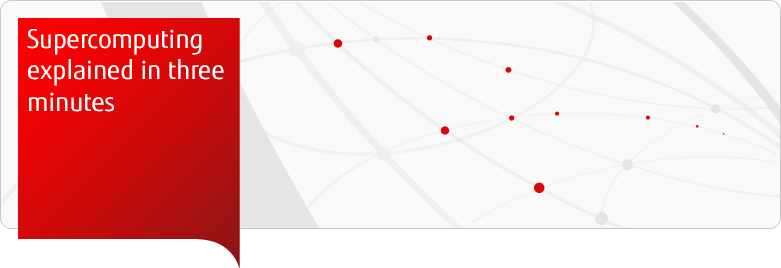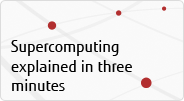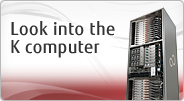- The possibilities
- About K computer
- Global Challenge and Fujitsu
- Quick guide to supercomputing
- Look into the K computer
- Supercomputing explained in three minutes
- Events
- Topics
- Brochures
- Links
Archived content
NOTE: this is an archived page and the content is likely to be out of date.
Supercomputing explained in three minutes

New tools for new challenges
Throughout the ages, humans have always sought to understand the world around them, often using tools to adapt to their environment and solve problems. As the challenges facing humans have become more sophisticated, so too have the tools they use. Early stone hammers have ultimately given way to ultra-high-speed supercomputers. These supercomputers are being used to address many of the pressing challenges facing society today. These include the need to:
- protect our environment more effectively and conserve natural resources
- develop new, renewable sources of energy
- mitigate the effects of climate change
- predict natural disasters such as earthquakes, tsunamis and storms and develop appropriate response plans for these increasingly frequent events, and
- develop new drugs to treat debilitating diseases.
The scale and complexity of these problems make progress difficult – traditional problem-solving techniques are simply too costly or time-consuming. Supercomputers have the ability to speed up this process.
It's all about speed
A supercomputer is simply a computer that can perform incredibly fast calculations. One of the fastest supercomputers in the world – the K computer – was developed by Fujitsu in partnership with RIKEN under the High Performance Computing Infrastructure Initiative promoted by the Japanese Ministry of Education, Culture, Sports, Science and Technology.
The K computer operates at a speed of 10 quadrillion calculations per second. To give you an idea of just how fast that is, imagine the following: All seven billion people in the world have a calculator and are asked to perform one calculation per second 24 hours a day, non stop. It would take the world's population approximately 17 days to do what the K computer can do in just one second. If we think of a regular desktop as a snail, then the K computer is a jet airplane.
This incredible speed makes supercomputers ideal for compute-intensive calculations and simulations. To simulate events such as car crashes, earthquakes and tsunamis, supercomputers need to handle massive volumes of data and that calls for exceptional computational horsepower.
A race
Around the globe, many countries are competing with each other to develop the world's fastest supercomputers. This race is inspired by the desire to advance research in a variety of fields. But it's not just research and development that benefit from supercomputers. They also drive innovation across a variety of industries by enhancing safety, design and environmental performance. In addition, a world-leading high-performance computing development environment attracts top-class scientists and fosters a culture of innovation. This – in turn – raises the bar for research and can even make a country more competitive if research findings are channeled into industry innovations. It's a bit like Formula One racing – the company with the fastest car attracts the best drivers and this technology ultimately finds its way into commercial and passenger vehicles.
Computing the answers to today's challenges
At the heart of any computer is the CPU – the central processing unit. Regular computers have a single CPU. By comparison, the K computer is equipped with over 80,000 CPUs. These CPUs were designed for maximum performance, high reliability and low power consumption. CPUs are only part of the picture, however. Equally important is the technology used to interconnect these processors and transmit data between them at ultra-high speeds. In total, over 200,000 cables extending over 1200 km were used for the innovative K computer interconnect network, which is managed by the LSI interconnect controller. The high-performance CPUs and innovative network technology played a key role in making the K computer the fastest machine in the world today.
The Japanese government plans to make the K computer available to a wide range of customers and research organizations. It will be used to support and accelerate the search for viable solutions to today's climate and environmental challenges, advance cutting-edge research and industry innovation and help make the world a safer place.
Note: About the K computer





